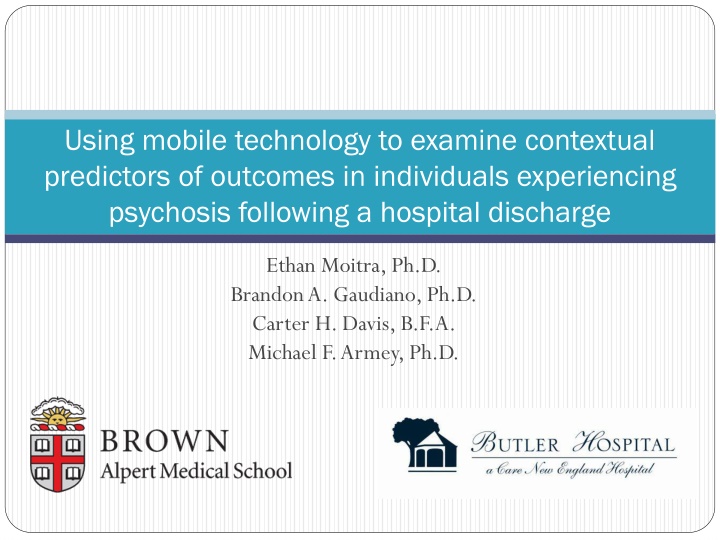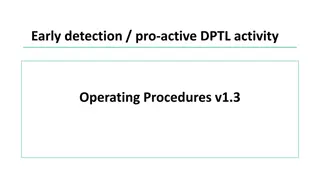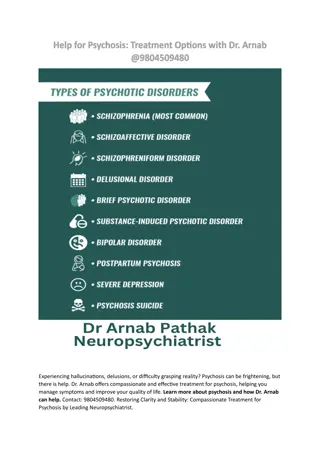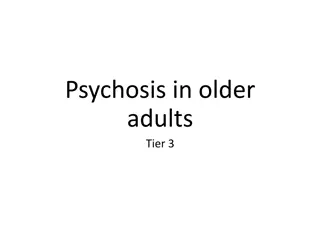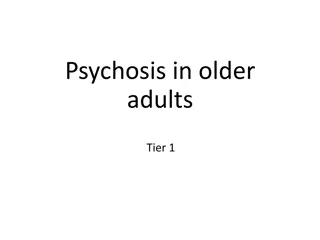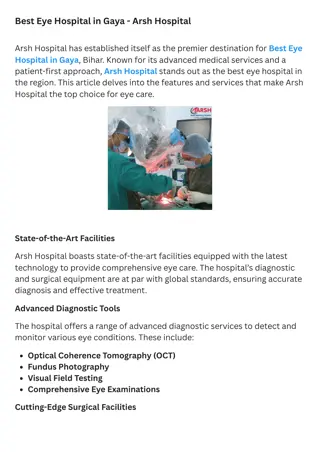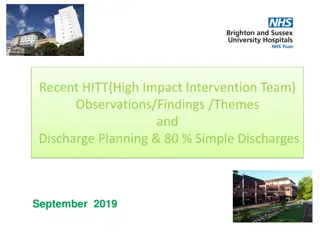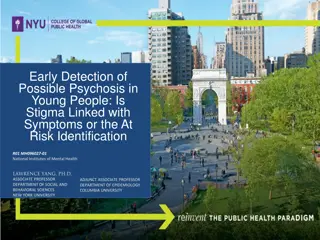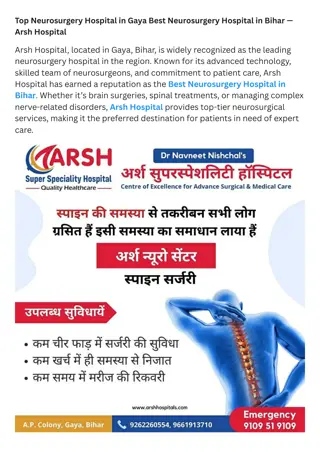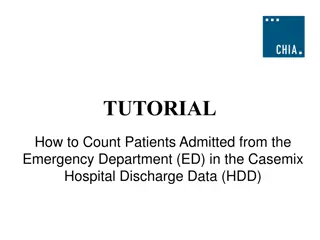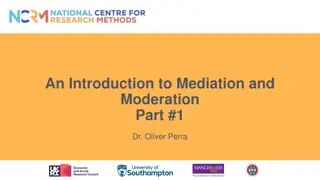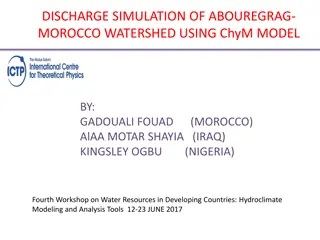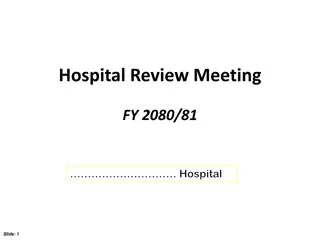Contextual Predictors of Psychosis Outcomes Post-Hospital Discharge
This study explores predictors of outcomes in individuals with psychosis post-hospital discharge using mobile technology. It addresses treatment nonadherence, the impact of antipsychotics, psychological flexibility, and the use of ecological momentary assessment (EMA). The research highlights the critical period of post-hospitalization, nonadherence costs, and the need for better continuity of care. Known predictors of nonadherence and remaining uncertainties are discussed, focusing on real-time fluctuations, impactful variables, coping mechanisms, and contextual influences.
Download Presentation

Please find below an Image/Link to download the presentation.
The content on the website is provided AS IS for your information and personal use only. It may not be sold, licensed, or shared on other websites without obtaining consent from the author.If you encounter any issues during the download, it is possible that the publisher has removed the file from their server.
You are allowed to download the files provided on this website for personal or commercial use, subject to the condition that they are used lawfully. All files are the property of their respective owners.
The content on the website is provided AS IS for your information and personal use only. It may not be sold, licensed, or shared on other websites without obtaining consent from the author.
E N D
Presentation Transcript
Using mobile technology to examine contextual predictors of outcomes in individuals experiencing psychosis following a hospital discharge Ethan Moitra, Ph.D. Brandon A. Gaudiano, Ph.D. Carter H. Davis, B.F.A. Michael F. Armey, Ph.D.
Disclosure of Commercial Support Relevant financial relationship: This study was funded by the National Institute of Mental Health (R21 #MH102000). The authors did not receive and will not receive any commercial support related to this presentation or the work presented in this presentation.
OUTLINE Treatment nonadherence in Psychotic Spectrum Disorders Post-hospitalization is a critical period Limitations in our current understanding of adherence predictors Are antipsychotics a necessary treatment? Psychological flexibility model of adherence Using ecological momentary assessment (EMA) to study adherence The present study Aims Design Participants Results Lessons Learned & Future directions
Psychotic Spectrum Disorders & treatment nonadherence Treatment costs $62.7 billion per year. 50% of patients are medication nonadherent. Nonadherence predicts: Relapse Rehospitalization Self- and other-harm Homelessness Improved adherence could save over $100 million per year in inpatient costs in Medicare.
Post-hospitalization is a critical period Medication nonadherence, session nonattendance, and drop- out increase rehospitalizations. Recent hospitalization predicts reduced adherence. The transition from inpatient to outpatient holds the highest risk of nonadherence and drop-out. Continuity of care in the transition from inpatient to outpatient care is limited.
Nonadherence predictors What we know What we know Treatment complexity Patient-provider alliance Treatment attitudes/beliefs Cost/access Side effects Stigma Forgetfulness Stressors Substance misuse Symptoms What we don t know What we don t know How do these variables fluctuate in real-time? Which variables are more impactful on adherence? Does context affect these barriers? How do patients cope with these barriers?
Are antipsychotics necessary? Limited impact on negative symptoms and functioning. Numerous (long-term) side effects. Some patients achieve better functioning after discontinuing antipsychotics under medical supervision. 30-40% of patients may do well with no/minimal antipsychotic pharmacotherapy. CBTs can lead to improvements independent of antipsychotics.
Psychological Flexibility model of medication adherence
Using EMA to study adherence Most studies have been cross-sectional or retrospective. Retrospective assessment is problematic because memory bias may influence self-reporting. EMA facilitates in vivo data collection.
Present Study: Aims Aim 1: To assess the feasibility and acceptability of post- hospital EMA in patients with psychotic-spectrum disorders Measured by: Recruitment Retention Adherence to protocols Patient feedback on acceptability Aim 2: To identify ecologically-valid and potentially modifiable post-hospital adherence predictors
Design Eligibility: Adults (18+ years old) Currently hospitalized at Butler Hospital in Providence, RI Psychotic-spectrum disorder diagnosis (SCID-assessed and corroborated with medical chart) Prescribed oral antipsychotic medication Assessments: Baseline interview/self-reports 1-month of EMA MEMS caps 1-, 2-, and 4-month follow-up interviews/self-reports
EMA protocol Random assessments: Environmental variables Substance use Affect Psychotic symptoms Psychological coping Stressful life events Social support Interference Satisfaction with life End-of-Day assessment: Appointment attendance Provider relationship Medication adherence Reasons for not taking medication Medication side effects
Participant flow Consented (49% of patients approached) N=65 Completed baseline N=55 Completed 1 EMA survey N=37
Participants characteristics Sex: 54% female (n=35) Age: mean=37.2 years old (SD=13.4) Race: 79% non-Latino White (n=51) Ethnicity: 89% non-Latino (n=58) Education: mean=13.0 years (SD=3.0) Marital status: 54% single, never married (n=35) Income: mode <$10,000/year Work status: 49% disabled (n=32)
Participant characteristics Primary diagnosis 40% 35% 30% 25% 20% 15% 10% 5% 0% Mood with Psychosis Psychosis NOS Schizoaffective Schizophrenia
Participant characteristics Antipsychotic medication 40% 35% 30% 25% 20% 15% 10% 5% 0%
Acceptability and Feasibility Results Acceptability: Overall likeability/usability: mean=39.9 (SD=6.6; max=50) Positive attitudes: Pleasant overall experience: mean=4.0 (SD=1.2) Would participate in a similar study in the future: mean=4.2 (SD=1.2) Negative attitudes: Difficulty operating the device: mean=2.4 (SD=1.5) Beeps interfered with activities: mean=2.1 (SD=1.2) Experience in the study was challenging: mean=2.3 (SD=1.4) *Items adapted from Kimhy et al. (2006); Scale=1-5, with higher ratings meaning greater agreement with the item.
Acceptability and Feasibility Results Qualitative feedback on acceptability: At first a little complicated, then I got used to it. Added some structure to my day. Kinda redundant. Feasibility: 89% owned a cell phone 65% of these were Smartphones 65% had unlimited texting 77% had internet access from their cell phones Reported problems: 20% of problems related to not wanting to use the device 16% of problems related to the device not powering on/battery issues 4% of device were lost 4% of device were damaged
EMA results 37 patients completed 1 survey Mean # of surveys completed=28.0 (SD=31.0) Min=1; Max=76 931 total random assessments completed 345 end-of-day assessments completed Environment: 65% completed in my home 44% completed alone 50% completed when inactive
EMA results Substance use since previous survey 8.00% 7.00% 6.00% 5.00% 4.00% 3.00% 2.00% 1.00% 0.00%
EMA results Stressful life event(s) since previous survey 3.00% 2.50% 2.00% 1.50% 1.00% 0.50% 0.00%
EMA results Outpatient appointment attendance 22 patients attended at least 1 appointment 49% were individual therapy sessions 34% were for medication management Medication nonadherence 7 patients reported nonadherence 4 reported >1 nonadherence event Side effects were reported in 58% of surveys
EMA results X X = Nonadherence event
EMA results X X = Nonadherence event
EMA results X X = Nonadherence event
Lessons Learned Using technology Working with overwhelmed patients Cost and systemic considerations
Future Directions Mobile device-based intervention? Adjunctive support via patients mobile devices?
